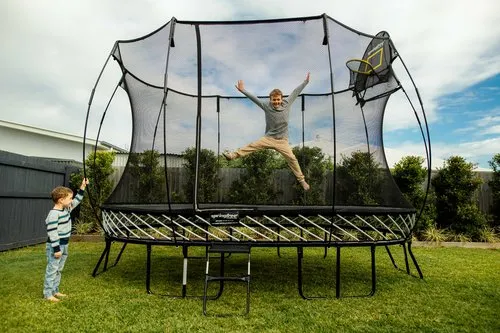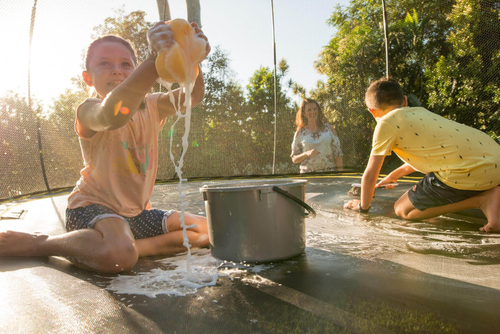When searching for a trampoline, have you asked yourself a question like this:
“If I buy this trampoline, will it actually last?”
This is one of the most common consumer questions about trampolines, and how long a trampoline lasts is a critical question to answer before buying a trampoline.
Like any product you buy, its longevity and ability to hold up through the years is a key factor to consider before purchasing.
This is especially true of trampolines: Trampolines cost anywhere from £100-£4,000+ depending on which one you purchase. No matter the cost, when you buy a trampoline, you expect it to last a reasonable amount of time for your family.
But what is a reasonable amount of time? How long should trampolines last?
Well, that is the question we will use our decades of experience as a trampoline innovator and manufacturer to answer today.
We created the world’s first springless trampoline, and independent research backs up the claim that they are also the world’s safest and most durable backyard trampolines.
With that being the case, we know a thing or two (or nearly everything) about the lifespan of a trampoline. And we want to use our platform to share that expertise with you in your journey to better jumping.
In this article, we will go over the main factors that affect garden trampoline’s lifespan, answer the question of how long they last with expertly crafted time ranges and finish off by giving you tried and true tips on how to sustain your trampoline.
4 Factors That Affect a Trampoline’s Lifespan
Let’s start by going over four of the major factors that affect how long an outdoor trampoline lasts:
Quality of Trampoline
The first and fundamental factor that plays into the lifespan of a trampoline is the quality of the trampoline itself.
The materials used in the construction of the trampoline are instrumental in how long it will last.
For instance, a trampoline that uses a galvanised steel frame, which involves applying a protective zinc coating to the steel, that’s painted and protected against rust and corrosion will be more likely to last than one that does not offer those same protections.
Furthermore, a trampoline net that uses high-strength polyester and is woven together knot-free is going to last longer than one that is not.
How the trampoline is built and designed is a direct factor in how long the parts of a trampoline will last, which of course is closely related to how long the product will last. For example:
- On a high-quality trampoline, the frame can last for 10-20 years, the mat can last for 5-10 years, the springs for 5-10 years and the enclosure net for 5-10 years.
- On a low-quality trampoline, the frame may only last for 5-10 years, the mat for 1-5 years, the springs for 1-3 years and the net for a couple of months to a year.
It is essential, if not a requirement, to inform yourself about how the trampoline you’re interested in was built before buying it if you want to project how long it will last.
A high-quality trampoline will be built with, among other things: A strong steel frame, sturdy springs (or rods on springless trampolines) a resilient net, stable trampoline poles and protection against rust and ultraviolet light from the sun.
The quality of the trampoline also affects the safety of the trampoline: If you have a trampoline that is falling apart, the injury risk of jumping in it is significantly increased, accentuating the importance of getting a good quality trampoline.
Environment
The next factor that affects the longevity of a trampoline is the environment in which it lives.
The weather plays a monumental role in how long a trampoline lasts. Particularly, ultraviolet light (UV) from the sun is the biggest threat to trampolines because it breaks down the material and decreases its strength.
If you have a trampoline that does not include UV protection for key parts like the padding or netting, and it sits in the sun all day, those parts can start to deteriorate, and it can lead to a breakdown of the trampoline. Because UV light can be detrimental to a trampoline, consider purchasing a trampoline sunshade or placing the trampoline in a shaded area.
Another weather-related element that can affect the trampoline is salt water, which if not maintained, can eat away at a trampoline’s frame and cause catastrophic frame failure.
If you live in a windy, rainy or snowy climate, you may also need to make arrangements for the trampoline when the weather is bad. Even some of the highest-quality trampolines can be affected by a ruthless storm.
Buying weather-related trampoline accessories or properly storing the trampoline are some of the actions you can take to make sure it holds up during inclement weather.
See the image below for a Springfree Trampoline with the Sunshade Accessory attached:

Frequency of Use
Next up on the list of factors that influence the life of a trampoline is how often the trampoline is being used.
Some trampolines can be jumped on for hours and hours a day for several years and still not show their age. Others may start to show wear and tear after a few months of frequent use.
This again ties into the quality of the trampoline: A trampoline that is built with sturdy and strong materials can withstand much more use than a trampoline made from inexpensive materials.
Insider Tip: A key indicator for how long the trampoline will be able to hold up under consistent use is how many hours or jumps they are tested to withstand. For example, our Springfree Trampolines are tested to 3 million jumps, more than any other trampoline on the market. Look for this number when looking to predict how long a trampoline will last.
Also tying into the point of how often the trampoline is used is what the trampoline is being used for and who’s using it.
If you have kids and they are using the trampoline for daily wrestling matches, it might wear down quicker than a trampoline that’s being used just for jumping.
The solutions for both of these issues: Set ground rules for jumpers using the trampoline and buy a trampoline that can safely hold the weight of all potential jumpers.
Maintenance
The last factor that affects how long a trampoline will last is the maintenance you provide for your trampoline. Every trampoline will need maintenance at some point.
This includes preventive measures that can help maintain your trampoline, like periodically cleaning the mat and springs or ordering trampoline replacement parts, like a trampoline replacement mat, in a timely fashion.
On a top-notch trampoline, maintenance will likely only include cleaning with soap and water and cleaning debris off the trampoline when needed. Replacement part changes are typically infrequent, although they will inevitably occur at some point if used enough.
On a lesser trampoline, maintenance can include much more frequent part changes, sometimes to the point where it would be more cost-effective to just replace your old trampoline with a new one.
Once again, this is where quality comes into play. If you want a trampoline to last for years and years of use without continuous maintenance, it’s worth it to go ahead and pay the premium price for a trampoline.

So…How Long Do Trampolines Last?
Now that you know the four main factors that play the biggest roles in the longevity of a trampoline, you’re ready for the answer to how long a trampoline lasts.
A good baseline average timeframe for a regular outdoor trampoline would be 3-8 years. Where your trampoline ends up on that timeframe depends on so many things, though. Let’s break down timeframes for some of the main categories so you get a feel for how long outdoor trampolines last:
- Cheap trampolines: 1-3 years
- Average trampolines: 3-8 years
- Premium trampolines: 5-10+years
- Above ground trampolines: 1-10+ years
- Inground trampolines (trampolines installed in the ground): 5-10+ years
(Check out inground trampolines vs. above ground for the differences between the two!)
As you can see, a trampoline’s lifespan will vary depending on, primarily, the four main factors we discussed in the last section.
Insider Tip: Check the warranty of the trampoline if you want to quickly assess the quality of the trampoline. It is a tell-tale sign of the manufacturer’s confidence in the product.
7 Tips for Sustaining Your Trampoline
You have a timeframe for how long trampolines last, but what can you do to help sustain your trampoline?
Here are seven tips to increase the lifespan of your trampoline:
What Are the Best Quality Trampolines?
If you’re spending your hard-earned money on a trampoline, you surely want it to become a staple in your garden for the long haul.
But getting a low-quality trampoline or not taking care of it properly could lead to it breaking down quicker than expected.
Luckily for you, you have all the control you need to purchase a trampoline that will last. The first and most important step to ensure the longevity of your trampoline is to buy a high-quality trampoline the first time.
Since we sell the highest quality trampolines, we know what makes separates good trampolines from bad trampolines. And we’ve made lists of the best trampolines you can buy this year, based on the different sizes you can buy.
We’ve ranked the best trampolines by price points, going from least expensive to most expensive, so there’s something for all budgets.









